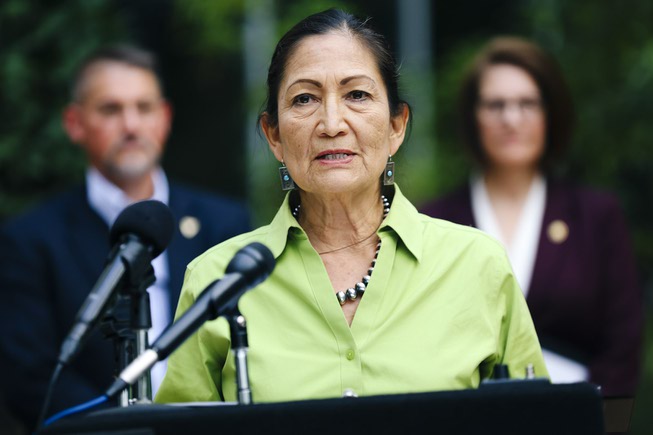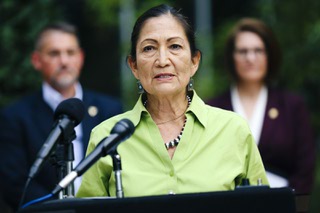
U.S. Secretary of the Interior Deb Haaland speaks at a press conference to discuss support for clean energy initiatives at NV Energy Tuesday, May 31, 2022.
Thursday, June 2, 2022 | 2 a.m.
The federal government, in its quest to advance clean energy production, is taking steps to reduce costs for utilities and other companies developing such projects on public lands.
Interior Secretary Deb Haaland, in a visit to Las Vegas, announced that the Department of Interior was reducing rents and fees for wind and solar projects on public lands by 50% for both existing and new projects.
The department will also build five renewable energy coordination offices to help process the increasing number of applications for wind, solar and geothermal developers. The initiative includes funding for new dedicated positions to support the project proposals.
“Through both of these efforts, renewable energy development on (Bureau of Land Management) managed public lands will continue to grow to support the nation’s energy needs, reduce our nation’s greenhouse gas emissions, and lower costs for families,” Haaland said.
The lease and fee savings could be substantial. According to the BLM’s website, the federal government charges a standard fee of up to $5,010 annually for each megawatt hour of energy produced by a project on public lands. That’s in addition to the land rental fee. In 2010, the base rent for a 4,000-acre solar project on public land in Clark County was about $$753,360, according to Basin and Range Watch.
Sen. Catherine Cortez Masto, D-Nev., and Rep. Steven Horsford, D-Nev., joined Haaland at the announcement, which took place Tuesday at NV Energy’s headquarters, where the three joined industry leaders for a roundtable discussion of the different renewable energy projects taking place in Nevada.
Consumers ultimately will be the beneficiaries of reduced costs for utilities and the companies building the renewable energy projects, the officials said.
“The focus we have here is ensuring that not only are we energy independent,” Cortez Masto said, “we’re protecting the future for our kids and families around clean energy, but we’re lowering costs for families as well.”
The two initiatives, supported with funds passed through the bipartisan Infrastructure Investment and Jobs Act, aim to meet President Joe Biden’s goal of permitting 25 gigawatts of solar, onshore wind and geothermal energy on public lands by 2025.
“There is an urgent need to make bold investments as we seek to decarbonize the economy and protect our communities,” Haaland said, “from coastal towns and rural farms to urban centers and tribal communities.”
Climate change, Haaland said, poses an “existential threat.”
In Nevada, climate change is causing more heat and more-intense heat waves, more droughts, loss of snowmelt, more frequent flooding, and an increased risk of wildfires, according to the Nevada Climate Initiative.
Nevada leads the nation in renewable energy projects on public lands, Horsford said. And the state is ranked sixth in clean energy capacity in development, trailing Texas, California, New York, Indiana and Virginia, according to the American Clean Power Association.
Finding the best places for renewable energy projects is a complicated matter.
Some projects come with consequences, such as Ormat Technologies’ plans to develop geothermal plants in Churchill County that could harm the imperiled Dixie Valley toad or the proposed Rhyolite Ridge lithium mine in Esmeralda County that could destroy Tiehm’s Buckwheat, a rare species of wildflower found only in a 10-acre plot within the proposed mine’s footprint.
Jon Raby, state director for the Bureau of Land Management in Nevada, said the bureau must ensure that it was “maintaining the integrity of lands in the process.”
Some Indigineous tribes in Nevada have also voiced opposition to renewable energy projects.
The Fallon Paiute-Shoshone Tribe filed a lawsuit against the geothermal project, for example, and several tribes have spearheaded an effort to make a national monument in Southern Nevada called the Avi Kwa Ame national monument, which would conserve the area and most likely thwart renewable energy projects.
“I think one of the most important things and something that has been a complete priority for this administration — President Biden’s — is tribal consultation,” said Haaland, the first Native American Cabinet secretary. “And we have taken that incredibly seriously. Tribes deserve to be engaged at the front side of anything, not after decisions are being made.”
Haaland on Wednesday was diagnosed with COVID and was isolating in Las Vegas.

